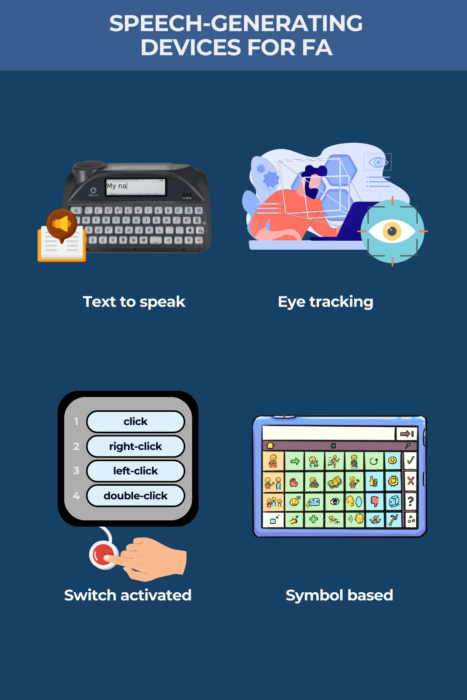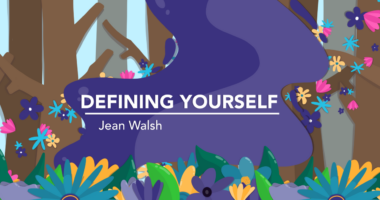Augmentative and alternative communication devices for FA
Last updated Sept. 20, 2024, by Susie Strachan
As Friedreich’s ataxia (FA) progresses, muscle weakness in your upper limbs and trunk can affect your speech. It can make it harder to speak and be understood, and you may need to use adaptive technology.
Eventually, your FA treatment may include working with a speech language pathologist (also known as a speech therapist) who can help you become familiar with adaptive technology for FA, including communication devices.
A number of augmentative and alternative communication (AAC) devices for people with FA can offer a range of options.
What are AAC devices?
AAC devices range from simple tools like pen and paper to more advanced digital devices that can make it easier for others to hear your voice or speak for you. Whatever the type, AAC devices for people with FA can help you communicate, stay connected to others, and maintain your independence.
The range of communication aids for people living with FA includes speech-generating devices that create spoken words from text inputs, eye-tracking devices for controlling communication software with eye movements, and switch-activated devices that allow you to navigate and select options with minimal physical effort, such as pressing a button with your finger or chin.
FA assistive technology also includes text-to-speech devices that convert written text into speech, and symbol-based communication methods, which use either a physical board or a digital app that shows pictures and icons representing common words and phrases. Then you select symbols to form sentences.
Assistive communication technology can be wearable or attach to a wheelchair or an adjustable stand. The height of the stand can be changed based on your position, such as sitting or lying down.
Speech-generating devices
Speech-generating devices (SGDs) convert text or symbols into spoken words. SGDs range from simple devices that generate a few basic phrases to more complex systems that have a large vocabulary and incorporate a digital version of your voice.
Tablets such as iPads can use communication apps such as Proloquo2Go and TouchChat to allow you to select words, phrases, or symbols that are converted into speech.
In addition to tablets, there are dedicated SGDs specifically for communication, such as the Tobii Dynavox or PRC devices. These often have features tailored for people who have significant physical limitations. For example, the devices might offer eye-tracking technology that allows you to control the device with your gaze.

Eye-tracking devices
Eye-tracking communication devices are specialized tools that can help people with FA who have difficulty with the fine motor skills needed for typing or pressing buttons on a device.
These devices track your eye movements, so you can control a communication system, such as a computer or tablet, by looking at specific areas of the screen.
The technology has cameras and sensors that detect where you are looking, giving you the ability to select language components by resting your gaze on the desired option or by blinking. Once a selection is made, the device can generate speech or convey information.
Switch-activated devices
Switch-activated devices are designed for people who have limited motor function but still have control over specific movements, such as pressing a button.
These devices are operated by activating a switch, which can be pressed with a body part you can control, such as your fingers, toes, or head.
When the switch is pressed, it triggers the communication system, enabling you to navigate through options on a screen. For example, you might press the switch to move a cursor across a selection of words or symbols and then press it again to choose the desired option.
There are a number of switch-activated communication devices on the market, including by Tobii, that can be paired with a variety of switch types, such as a button switch or a sip-and-puff switch.
Text-to-speech devices
Text-to-speech devices are intended for individuals who can type and wish to communicate using synthesized speech.
These devices turn what you type into spoken words, helping you communicate easily in real time, whether you’re having a conversation in person, over the phone, or online.
Some text-to-speech systems offer customizable voices. For example, you might want to select different accents, tones, gender, or adjust the speed and pitch of the voice to match your preferences.
Text-to-speech devices can either be standalone or use apps installed on tablets, smartphones, or computers.
Standalone devices are specifically designed for converting text to speech and are often dedicated to that function. Apps installed on general-purpose devices such as tablets or smartphones provide the same text-to-speech capability but may offer more flexibility.
Symbol-based communication apps
Symbol-based communication devices help you communicate by selecting pictures or symbols that represent words or concepts.
With a symbol-based system, you can tap or point to images that convey your intended message. They may be a physical item, such as a board or symbol book, or digital, such as an app on a tablet, smartphone, or computer screen.
For example, symbols might include a picture of a glass to represent “drink,” a smiley face to indicate “happy,” or an apple for “food.” To say “I want to eat an apple,” you might choose first a picture of a person, followed by a hand reaching for something, a plate with food, and a picture of an apple.
Digital apps can offer the added benefit of voice output, allowing the selected symbols to be spoken aloud.
Support and training
Speech therapy tools, particularly AAC devices for people with FA, can be an invaluable aid for helping you communicate. But with so many options available, it can take some trial and error to figure out the device that best meets your needs, and it may change over time. Depending on what you are trying to do, you may want more than one device.
A speech language pathologist can help with selecting the most appropriate AAC devices for people with FA. They will assess your needs and symptoms of FA, including difficulty speaking and fine motor skills.
Your speech therapist can suggest when you should consider changing AAC devices by monitoring the progression of your FA symptoms.
- In the early stages, you might need communication aids such as text-to-speech apps.
- In the middle stages, you might need to use voice banking and your recorded voice with speech-generating devices.
- In the later stages, you might need to use switch-activated or eye-gaze communication devices.
Your speech therapist also can help you set up vocabulary on your AAC device and train your family and caregivers on how to use it.
In addition, your speech therapist can consult other members of your FA healthcare team who are helping address speech difficulties, such as a physical therapist or an occupational therapist.
A physical therapist can assist with improving your motor skills and coordination, which can affect your ability to use speech-generating devices. An occupational therapist can work with you on strategies for using AAC devices more effectively.
Friedreich’s Ataxia News is strictly a news and information website about the disease. It does not provide medical advice, diagnosis, or treatment. This content is not intended to be a substitute for professional medical advice, diagnosis, or treatment. Always seek the advice of your physician or other qualified health provider with any questions you may have regarding a medical condition. Never disregard professional medical advice or delay in seeking it because of something you have read on this website.
Recent Posts
Related articles





